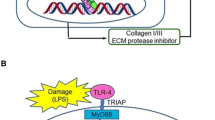Abstract
Co-therapy with rifampicin (RIF) and isoniazid (INH) used to treat tuberculosis in humans frequently causes liver injury. Here, using a pregnane X receptor (PXR)-humanized mouse model, we found that co-treatment with RIF and INH causes accumulation of the endogenous hepatotoxin protoporphyrin IX in the liver through PXR-mediated alteration of the heme biosynthesis pathway. These results provide insight into the mechanism of liver injury induced by co-treatment with these compounds and may lead to their safer use in the clinic.


Similar content being viewed by others
References
Saukkonen, J.J. et al. Am. J. Respir. Crit. Care Med. 174, 935–952 (2006).
Yew, W.W. & Leung, C.C. Respirology 11, 699–707 (2006).
Chowdhury, A. et al. J. Hepatol. 45, 117–126 (2006).
Tasduq, S.A., Kaiser, P., Sharma, S.C. & Johri, R.K. Hepatol. Res. 37, 845–853 (2007).
Kliewer, S.A. et al. Cell 92, 73–82 (1998).
Lehmann, J.M. et al. J. Clin. Invest. 102, 1016–1023 (1998).
Xing, T., Chen, J. & Zhang, G. Zhonghua Jie He He Hu Xi Za Zhi 20, 33–35 (1997).
Gangadharam, P.R. Am. Rev. Respir. Dis. 133, 963–965 (1986).
Huang, Y.S. et al. Hepatology 37, 924–930 (2003).
Ohno, M. et al. Int. J. Tuberc. Lung Dis. 4, 256–261 (2000).
Miguet, J.P., Mavier, P., Soussy, C.J. & Dhumeaux, D. Gastroenterology 72, 924–926 (1977).
Slatter, J.G. et al. Xenobiotica 36, 938–962 (2006).
Rosenfeld, J.M., Vargas, R. Jr., Xie, W. & Evans, R.M. Mol. Endocrinol. 17, 1268–1282 (2003).
Mitchell, J.R. et al. Ann. Intern. Med. 84, 181–192 (1976).
Sarich, T.C. et al. Arch. Toxicol. 70, 835–840 (1996).
Metushi, I.G., Nakagawa, T. & Uetrecht, J. Chem. Res. Toxicol. 25, 2567–2576 (2012).
Casanova-González, M.J., Trapero-Marugan, M., Jones, E.A. & Moreno-Otero, R. World J. Gastroenterol. 16, 4526–4531 (2010).
Anstey, A.V. & Hift, R.J. Gut 56, 1009–1018 (2007).
Fraser, D.J., Zumsteg, A. & Meyer, U.A. J. Biol. Chem. 278, 39392–39401 (2003).
Ma, X. et al. Drug Metab. Dispos. 35, 194–200 (2007).
Staudinger, J.L. et al. Proc. Natl. Acad. Sci. USA 98, 3369–3374 (2001).
Acknowledgements
This work was supported by the National Institute of Diabetes and Digestive and Kidney Diseases (grant number DK090305) and the National Cancer Institute Intramural Research Program. We thank M. Montello for editing the manuscript.
Author information
Authors and Affiliations
Contributions
F.L., J.L., J.C., L.W., T.M., I.L.C. and X.M. performed the experiments. C.D.K. and F.J.G. contributed to the scientific discussion and manuscript editing. X.M. and F.L. conceived the project and wrote the manuscript.
Corresponding author
Ethics declarations
Competing interests
The authors declare no competing financial interests.
Supplementary information
Supplementary Text and Figures
Supplementary Figures 1–5 (PDF 700 kb)
Rights and permissions
About this article
Cite this article
Li, F., Lu, J., Cheng, J. et al. Human PXR modulates hepatotoxicity associated with rifampicin and isoniazid co-therapy. Nat Med 19, 418–420 (2013). https://doi.org/10.1038/nm.3104
Received:
Accepted:
Published:
Issue Date:
DOI: https://doi.org/10.1038/nm.3104
- Springer Nature America, Inc.
This article is cited by
-
Polymorphisms in drug metabolism genes as a risk factor for first-line anti-tuberculosis drug-induced liver injury
Molecular Biology Reports (2023)
-
Probiotics mixture reinforces barrier function to ameliorate necrotizing enterocolitis by regulating PXR-JNK pathway
Cell & Bioscience (2021)
-
LC–MS-Based Metabolomics in the Study of Drug-Induced Liver Injury
Current Pharmacology Reports (2019)
-
Genetic Variations Associated with Anti-Tuberculosis Drug-Induced Liver Injury
Current Pharmacology Reports (2018)
-
Mechanisms of Inflammatory Liver Injury and Drug-Induced Hepatotoxicity
Current Pharmacology Reports (2018)





